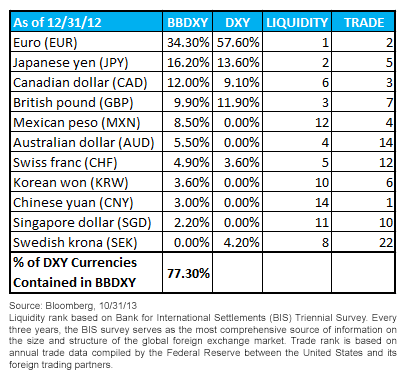What Is the U.S. Dollar Worth?


 In response to the evolution of the global market place, the Bloomberg Dollar Spot Index (BBDXY) attempts to proxy the value of the dollar against a broader basket of foreign currencies. In addition to identifying the largest trading partners of the U.S., it also conducts a screen for currencies with the greatest level of fx turnover. Not only does this make BBDXY more diversified and dynamic, it also provides an intuitive measure of the dollar in the global marketplace. Given that the index conducts an annual screening process to determine the weights and constituent currencies, BBDXY is able to incorporate changes in the evolution of the global markets. With emerging markets now accounting for nearly 40% of global gross domestic product (GDP), it is imperative that the value of their currencies be tracked against the U.S. dollar.
Ultimately, we believe that a dynamic approach should be taken to adequately assess the value of the U.S. dollar. By focusing not only on the most liquid global currencies but also on the largest trading partners of the U.S., the Bloomberg Dollar Spot Index provides a broad-based and intuitive approach to valuing the U.S. dollar against a basket of foreign currencies.
In response to the evolution of the global market place, the Bloomberg Dollar Spot Index (BBDXY) attempts to proxy the value of the dollar against a broader basket of foreign currencies. In addition to identifying the largest trading partners of the U.S., it also conducts a screen for currencies with the greatest level of fx turnover. Not only does this make BBDXY more diversified and dynamic, it also provides an intuitive measure of the dollar in the global marketplace. Given that the index conducts an annual screening process to determine the weights and constituent currencies, BBDXY is able to incorporate changes in the evolution of the global markets. With emerging markets now accounting for nearly 40% of global gross domestic product (GDP), it is imperative that the value of their currencies be tracked against the U.S. dollar.
Ultimately, we believe that a dynamic approach should be taken to adequately assess the value of the U.S. dollar. By focusing not only on the most liquid global currencies but also on the largest trading partners of the U.S., the Bloomberg Dollar Spot Index provides a broad-based and intuitive approach to valuing the U.S. dollar against a basket of foreign currencies.Important Risks Related to this Article
Foreign investing involves special risks, such as risk of loss from currency fluctuation or political or economic uncertainty. Investments in currency involve additional special risks, such as credit risk and interest rate fluctuations. Diversification does not eliminate the risk of experiencing investment losses.

Rick Harper serves as the Chief Investment Officer, Fixed Income and Model Portfolios at WisdomTree Asset Management, where he oversees the firm’s suite of fixed income and currency exchange-traded funds. He is also a voting member of the WisdomTree Model Portfolio Investment Committee and takes a leading role in the management and oversight of the fixed income model allocations. He plays an active role in risk management and oversight within the firm.
Rick has over 29 years investment experience in strategy and portfolio management positions at prominent investment firms. Prior to joining WisdomTree in 2007, Rick held senior level strategist roles with RBC Dain Rauscher, Bank One Capital Markets, ETF Advisors, and Nuveen Investments. At ETF Advisors, he was the portfolio manager and developer of some of the first fixed income exchange-traded funds. His research has been featured in leading periodicals including the Journal of Portfolio Management and the Journal of Indexes. He graduated from Emory University and earned his MBA at Indiana University.

